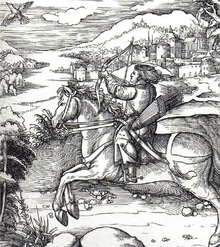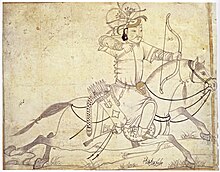Mounted archery
In large open areas, mounted archery was a highly successful technique for hunting, for protecting herds, and for war.[9] The term mounted archer occurs in medieval English sources to describe a soldier who rode to battle but who dismounted to shoot, similar to the later firearm-equipped dragoons.[14] Since using a bow requires the rider to let go of the reins with both hands, horse archers need superb equestrian skills if they are to shoot on the move.[16][17] Horse archery was for many groups a basic survival skill, and additionally made each able-bodied man, at need, a highly mobile warrior.[20] Captain Robert G. Carter described the experience of facing Quanah Parker's forces: "an irregular line of swirling warriors, all rapidly moving in right and left hand circles.. while advancing, to the right or left, and as rapidly concentrating... in the centre... and their falling back in the same manner...all was most puzzling to our... veterans who had never witnessed such tactical maneuvers, or such a flexible line of skirmishers"[21] In the tactic of the Parthian shot the rider would retreat from the enemy while turning his upper body and shooting backward.[26] An example of these tactics comes from an attack on Comanche horse archers by a group of Texas Rangers, who were saved by their muzzle-loading firearms and by a convenient terrain feature.[29] The Rangers immediately retreated, only to discover they had committed a classic error in fighting mounted archers: the Comanches pursued in turn, able to shoot what seemed like clouds of arrows.[4] Horse archers may be either light, such as Scythian, Hun, Parthian, Cuman, or Pecheneg horsemen, or heavy, such as Byzantine kavallarioi, Turkish timariots, Russian druzhina and Japanese samurai.The earliest depictions are found in the artwork of the Neo-Assyrian Empire of about the 9th century BC and reflect the incursions of the early Iranian peoples.[43] Skirmishing requires vast areas of free space to run, maneuver, and flee, and if the terrain is close, light horse archers can be charged and defeated easily.The Roman general Crassus led a large army, with inadequate cavalry and missile troops, to catastrophe against Parthian horse archers and cataphracts at the Battle of Carrhae.Philip of Macedon scored an epic victory against the Scythians residing north of the Danube, killing their king, Ateas, and causing their kingdom to fall apart thereafter.[45] The Roman Empire and its military also had extensive use of horse archers after their conflict with eastern armies that relied heavily on mounted archery in the 1st century BC.[47] Heavy horse archers, instead of skirmishing and hit-and-run tactics, formed in disciplined formations and units, sometimes intermixed with lancers as in Byzantine and Turkish armies, and shot as volleys instead of shooting as individuals.Likewise, the Turkish timariot and qapikulu were often as heavily armored as Western knights and could match the Hungarian, Albanian, and Mongol horse archers.[50] The invention of spanning mechanisms such as the goat's foot lever and the cranequin allowed mounted crossbowmen to reload and fire heavy crossbows on horseback.16th-century dragoons and carabiniers were heavier cavalry equipped only with firearms, but pistols coexisted with the composite bow, often used by the same rider, well into the 17th century in Eastern Europe, especially with the Russians, Kalmyks, Turks, and Cossacks.By the 18th century, firearms had largely displaced traditional composite bows in Mongolia, whereas in Manchuria horse archery was still highly esteemed.Baron de Marbot writes that on the eve of the Battle of Leipzig, his forces encountered mounted archers: With much shouting, these barbarians rapidly surrounded our squadrons, against which they launched thousands of arrows which did very little damage because the Baskirs, being entirely irregulars, do not know how to form up in ranks and they go about in a mob like a flock of sheep, with the result that the riders cannot shoot horizontally without wounding or killing their comrades who are in front of them, but shoot their arrows into the air to describe an arc which will allow them to descend on the enemy.In the past five years a desire to revive the tradition seems to have been addressed with the foundation of the Mongolian Horseback Archery Association whose members have competed in South Korea and Europe.[73] Tibetan Buddhist monks, Muslim women and musicians were obtained and provided to Zhengde by his guard Ch'ien Ning, who acquainted him with the ambidextrous archer and military officer Chiang Pin.[74] An accomplished military commander and archer was demoted to commoner status on a wrongful charge of treason was the Prince of Lu's grandson in 1514.To maintain traditional Japanese horse archery, Tokugawa Yoshimune, the shōgun, ordered the Ogasawara clan to found a school.Kassai Lajos created a competitive rule system of horse archery in the late 1980s,[89] and started to propagate this new form of the sport, first in Hungary, and from the 1990s in the rest of Europe, the United States, and Canada.












arrowson horsebackArcheryEurasian nomadsmedieval periodIranian peoplesSarmatiansCimmeriansScythiansMassagetaeParthiansPersiansAntiquityHungariansMongolsChineseTurkic peoplesMiddle AgesEastern EuropeWest AsiaEast AsiasamuraiYabusamedragoonsthe North American prairiesComanchesHoly Roman Emperor Maximilian IAlbrecht DürerTimuridIlkhanidequestrianbowhuntingskirmishersRobert G. CarterQuanah ParkerParthian shotComancheTexas RangersScythianParthianPechenegCumanscataphractsknightsPalazzo Madama, TurinIron AgechariotNeo-Assyrian Empirechariot warfarecataphractlamellar armorMeroiticCrassusBattle of Carrhaecampaign against the mounted ScythiansPhilip of MacedonAlexander the GreatBattle of JaxartesSyr DaryaGreek invasion of IndiaEquites SagittariiCrusadersTurcopoledruzhinaLý Công UẩnĐại ViệtLý Thánh TôngInvasion of Song ChinaChampaKhmer Empiremounted crossbowmenKonungs skuggsjáfirearmarquebusmusketcarbinecompositerecurve bowcarabinierscomposite bowsManchuriaBattle of KhorgosDzungarsQing DynastyManchu bowsQing Dynasty in 1911Napoleonic WarsRussian Imperial ArmyBaron de MarbotBattle of Leipzigbuffalo huntingFrancis ParkmanAmerican Indian WarsComposite bowDomestication of the horseMongoliaNaadamChinese archeryreliefHan dynastyNational Museum of Oriental ArtSix ArtsGuozijianequestrianismMing dynastyHongwu EmperorImperial ExaminationsEmperor XiaozongHongxi EmperorWanli EmperorGosannen WarHeian periodWarring States periodNasu no YoichiKamakura periodKasagakeInuoumonoTokugawa YoshimuneshōgunOgasawara clanKassai LajosEuropeUnited StatesCanadaHorses in East Asian warfareMongol bow